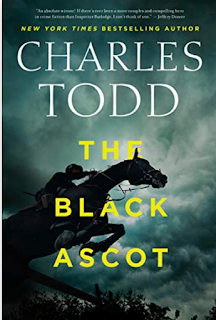“It’s the taint of a shell-shock diagnosis, something considered so offensive and humiliating in postwar society that it can terminate Rutledge’s career almost as quickly as a bullet to the head.”
Charles Todd’s Inspector Ian
Rutledge series opens its 21st title with a tip of the hat to a 1910 event well
known in England, but perhaps not to American readers: the “Black Ascot,” when
the traditional glittering social occasion of the royally established horse
race faced a catastrophe of timing. King Edward VII died, and the royal house
was in deep mourning, with the nation hardly less so. In a brilliant
adaptation, the “glitterati” attended in mourning dress: clad entirely in
black.
In a death related to the
race are the seeds of the tragedy and linked crimes than Inspector Ian Rutledge
finds himself investigating eleven years later, in his postwar resumed post
with Scotland Yard. Not that the case is obvious to start with—in fact,
Rutledge simply responds to a village crisis, an overwrought man on a church
roof, holding a girl hostage with a shotgun.
Fans of the series will give
a quiet “hoorah” for the immediate presence of Rutledge’s haunting inner voice,
that of his wartime colleague Hamish, warning Ian of the perils in the rescue
he attempts. There’s an unexpected gift to Rutledge when he resolves things:
word of an observation of a “most wanted” murderer from that 1910 event, Alan
Barrington.
The information offered at
the start of The Black Ascot
positions Rutledge on dubious ground (as usual) with his superior:
Rutledge made good time back to London. And for most of the drive, he mulled over Danny’s sighting of Alan Barrington, and whether or not to mention it to Chief Superintendent Jameson. … If the sighting proved true, and the Yard wasn’t informed then he would be derelict in his duty.Hamish, stirring in the back of his mind, said, ‘He’ll be more fashed if you send him chasing after wild geese.’
Of course, since the Chief
Superintendent heartily despises Rutledge, the hunt for a near-vanished deadly
criminal is also a possible way to humiliate the inspector with that wild goose
chase, and possibly even to fire him. So the hunt is on.
Charles Todd is a master plot
tangler, and in the hands of this mother-son author team, Rutledge must comb
apart society’s powerful connections, apparent love matches that turn abusive,
and more. Because he’s hunting Alan Barrington, he’s pitting his wits and
emotional understanding against some passionate defenders of the accused—people
who will do almost anything to prevent Barrington’s capture and trial. He’ll
also pry into a family’s desperate efforts to protect an outcast and a hidden
set of long-ago crimes.
The enduring appeal of this
series is its subtle and poignant probing of the damage done by the Great War:
to Ian Rutledge, to England’s upper classes and villages alike, and to a nation’s
concept of itself as gracious and lovely. At front and center this time is not
the struggle between Ian and the part of himself that speaks with Hamish’s
voice. Instead, it’s the taint of a shell-shock diagnosis, something considered
so offensive and humiliating in postwar society that it can terminate
Rutledge’s career almost as quickly as a bullet to the head.
So solving the Barrington
case, and capturing the killer, becomes Rutledge’s only hope for his
self-respect and his job. As the pages fly past, Charles Todd takes this
investigator into tangled boundaries and razor-sharp fences. The best kind of
suspense is generated: believing that somehow the inspector will come through,
but not knowing, from one moment to the next, how on earth he and his fragile
network of support will find a way out of the war-torn darkness.
PS: Looking for more mystery reviews, from cozy to very dark? Browse the Kingdom Books mysteries review blog here.
-->
PS: Looking for more mystery reviews, from cozy to very dark? Browse the Kingdom Books mysteries review blog here.

No comments:
Post a Comment